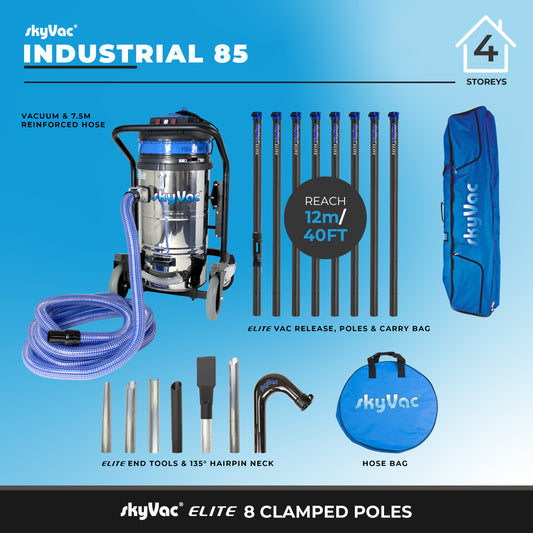Conquering High Interior Dusting: Tips and Tricks for a Sparkling Home
Share
We all know that dust loves to settle everywhere, but have you ever looked up and noticed that layer of grime on the ceiling fans, light fixtures, or the tops of cabinets? High interior dusting can feel like a chore nobody wants to tackle. It's out of sight, out of mind, right? But ignoring these high spots means dust and allergens can just keep building up, affecting our air quality and making our homes feel less clean. Let's talk about how we can conquer those hard-to-reach places and get our whole home sparkling.
Key Takeaways
- Dust and dander naturally float upwards and collect on high surfaces like ceiling beams, light fixtures, and vents, impacting air quality and potentially creating fire hazards.
- Using specialized tools such as long-reach poles and various dusting or vacuum attachments makes high interior dusting safer and more effective than using ladders or chairs.
- The 'top-down' cleaning method is key; always start with the highest areas and work your way down to prevent dust from falling onto already cleaned surfaces.
Understanding The Need For High Interior Dusting
Why Dust Gathers In High Places
We often focus on the surfaces we see every day, like tables and floors, but what about the areas way up high? Dust doesn't just magically disappear; it actually tends to collect in the most out-of-the-way spots. Think about how air moves in a room. Warm air rises, and so do tiny particles like dust, skin cells, pet dander, and fibers from our clothes. These lightweight bits get carried up by air currents, whether it's from your heating and cooling system, a gentle breeze from an open window, or just people moving around. Over time, these particles settle on ceiling beams, the tops of cabinets, light fixtures, fan blades, and even inside vents. It's a natural process, but it means these high areas become hidden dust traps.
The Impact Of Neglected Overhead Dust
When we leave these high places untouched for too long, a few things can happen. First, that settled dust can become a problem for our air quality. When disturbed, even by a slight draft, these particles can get kicked back into the air we breathe. For anyone with allergies or respiratory issues, this can be a real bother.
Beyond air quality, think about safety. Dust buildup, especially around electrical components or heat sources, can pose a fire risk. It might seem unlikely, but it's a genuine concern in many spaces.
Finally, there's the simple matter of appearance. Visible dust on high shelves or beams just doesn't look good. It can make a space feel less clean and well-maintained, which isn't the impression we want to give, whether it's in our own homes or a business.
It's easy to forget about the dust that settles far above our heads. But these neglected areas can impact our health, safety, and the overall look of our surroundings. Addressing high dusting isn't just about tidiness; it's about creating a healthier and more pleasant environment for everyone.
Essential Tools And Techniques For High Interior Dusting
Now that we understand why those high-up spots need attention, let's talk about how we actually get them clean. Tackling dust that's settled on ceiling fans, beams, or the tops of cabinets requires a different approach than your usual dusting routine. It’s all about having the right gear and knowing the best way to use it.
Choosing The Right High-Reach Poles
When we're talking about reaching those lofty areas, the pole is your best friend. We need something sturdy but also lightweight enough that we don't get worn out after a few minutes. Carbon fiber poles are fantastic for this; they're incredibly light and strong, which makes a huge difference when you're maneuvering them overhead.
- Telescopic poles are great because you can adjust the length easily, making them versatile for different heights and spaces. They usually have secure clamps to keep them at the desired length.
- Clamped pole sets are made of interlocking sections. These can offer extra rigidity, which is helpful if you're using heavier attachments or need a very stable reach.
- Look for poles that can extend significantly, often up to 40 feet, so you can clean from the safety of the ground.
Effective Dusting And Vacuum Attachments
Just having a long pole isn't enough; we need to attach the right tool to the end. The type of attachment you use will depend on what you're cleaning and whether you want to capture the dust or just move it.
- Microfiber dusting heads are excellent for dry dusting. They attract and hold onto dust particles effectively. Many are washable, which is a big plus.
- For vacuuming, specialized vacuum attachments connect to your pole. These are designed to fit onto vents, pipes, and ledges, sucking up dust and debris directly. Using a vacuum system means the dust doesn't just get redistributed into the air.
- Various brushes are available, some with specific angles or shapes, to get into corners, around light fixtures, or along beams.
The key is to select attachments that are designed for high-reach cleaning. These are often shaped to work with the angle of the pole and the surfaces you're cleaning, making the job much more efficient and less frustrating.
Mastering The Top-Down Cleaning Method
This is a simple but really important technique. When we clean, gravity is always at play. Dust and debris will fall downwards. So, to avoid having to re-clean areas, we always start high and work our way down.
- Begin with the highest surfaces in the room – think ceiling corners, tops of tall furniture, light fixtures, and beams.
- Use your chosen high-reach pole and attachment to dust or vacuum these areas.
- As you work, any dust that falls should land on surfaces that you haven't cleaned yet.
- Once you've finished all the high areas, move on to cleaning the mid-level surfaces, and finally, the floors.
Following this method means you're not undoing your own work. It’s a straightforward way to make sure your entire space ends up sparkling clean, from the highest cobweb to the lowest floorboard.
Keeping high places clean can be tricky, but with the right gear and tricks, it's totally doable. We're talking about getting rid of dust and gunk from ceilings, beams, and other hard-to-reach spots without breaking a sweat. Want to learn the best ways to tackle these dusty jobs and keep your space looking sharp? Check out our website for all the pro tips and tools you'll need!
Wrapping Up Our High Dusting Journey
So, there you have it! We've covered why dust loves to hang out in those high-up spots and how to tackle it without needing a ladder or a circus act. Remember, keeping those ceilings and beams clean isn't just about looks; it's about breathing easier and keeping our spaces safer. With the right tools, like those from SkyVac and Clean Direct, we can make even the highest dusting jobs feel manageable. We hope these tips help you achieve that sparkling, dust-free home you've been aiming for. Happy dusting!
Frequently Asked Questions
Why does dust seem to gather more in high places?
Think of dust like tiny, light feathers. When we move around or when air flows through our homes, these light particles get lifted up. Because warm air naturally rises, and air currents from fans or vents push things around, dust and dander often end up settling on the highest surfaces like ceilings, light fixtures, and the tops of cabinets. It's just physics at play!
What kind of tools do we need for dusting high areas?
We don't need to break out the stepladder every time! Special tools make it much easier and safer. We can use long poles that extend quite far, so we can reach those high spots from the floor. These poles can attach to different cleaning heads, like brushes or microfiber dusters, and some even connect to vacuums to suck up the dust as we go, preventing it from falling everywhere.
Is it really important to clean dust from high places?
Absolutely! It’s more than just making things look cleaner. Dust up high can include things like allergens, pet dander, and even tiny bits of mold. When this dust gets stirred up, it can float around and we can breathe it in, which isn't good for our lungs, especially if we have allergies or asthma. Plus, a big buildup of dust near lights or vents could even be a fire hazard. So, keeping those high spots clean helps us breathe easier and keeps our homes safer.








